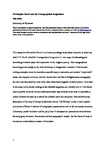Christopher Smart and the Cartographic Imagination
| dc.contributor.author | Wild, Min | |
| dc.date.accessioned | 2017-11-22T15:42:24Z | |
| dc.date.issued | 2018-01-19 | |
| dc.identifier.issn | 0034-6551 | |
| dc.identifier.issn | 1471-6968 | |
| dc.identifier.uri | http://hdl.handle.net/10026.1/10258 | |
| dc.description.abstract |
This essay identifies within Smart's mid-century writings those places where he is seized by what D. K. Smith called the 'cartographical imagination'; new ways of delineating and describing terrestrial space find expression in his religious poetry. This topographical borrowing is not simply on the level of concept or imagination, however: I find several striking examples where he describes a specific map or cartouche, and reveal a 'mapminded' Smart who enjoyed and knew well the visual colour and life of Enlightenment cartography, but who was disquieted by some of its silent rhetorical arrogation of divine power. I turn later in the essay to his secular writings in the Midwife magazine, and identify how in 1750 Smart used a specific sixteenth-century anthropomorphic map (devised at the time to symbolize a united Christian Europe) as a vehicle for political satire and bad jokes. This satirical prose description of the map of Europe transformed into an 'Old Woman' is also a more explicit articulation of Smart's distrust of cartographic representation and its all-too-human concerns. Ultimately, amidst the banter and the play, Smart's idiosyncratic presentation demonstrates his early grasp of twenty-first-century cultural geography's insight: that the claim of maps to transparent authenticity is a matter of deception. | |
| dc.format.extent | 686-705 | |
| dc.language | en | |
| dc.language.iso | en | |
| dc.publisher | Oxford University Press (OUP) | |
| dc.title | Christopher Smart and the Cartographic Imagination | |
| dc.type | journal-article | |
| dc.type | Journal Article | |
| plymouth.issue | 291 | |
| plymouth.volume | 69 | |
| plymouth.publication-status | Published | |
| plymouth.journal | The Review of English Studies | |
| dc.identifier.doi | 10.1093/res/hgx131 | |
| plymouth.organisational-group | /Plymouth | |
| plymouth.organisational-group | /Plymouth/Faculty of Arts, Humanities and Business | |
| plymouth.organisational-group | /Plymouth/REF 2021 Researchers by UoA | |
| plymouth.organisational-group | /Plymouth/REF 2021 Researchers by UoA/UoA27 English Language and Literature | |
| plymouth.organisational-group | /Plymouth/Users by role | |
| plymouth.organisational-group | /Plymouth/Users by role/Academics | |
| dcterms.dateAccepted | 2017-11-17 | |
| dc.rights.embargodate | 2020-1-19 | |
| dc.identifier.eissn | 1471-6968 | |
| dc.rights.embargoperiod | Not known | |
| rioxxterms.versionofrecord | 10.1093/res/hgx131 | |
| rioxxterms.licenseref.uri | http://www.rioxx.net/licenses/all-rights-reserved | |
| rioxxterms.licenseref.startdate | 2018-01-19 | |
| rioxxterms.type | Journal Article/Review |


